Okay, so you survived the American Thanksgiving, Black Friday (apparently also known as “Brown Friday” because of the propensity for people in line to shit in odd places so as not to lose their places in line), and Cyber-Monday, Sexting Tuesday, Make It Stop Wednesday, and Maybe I’ll Just Stop Looking at the Internet Thursday.
So, to continue in that spirit of perceived excess and yet strangely unsatisfied longings, why not try Jeff’s Blue Sunday? Yes, after the jump, I will be giving micro-reviews of every book I’ve read so far this month in the order I read them. Wooo! Right? Wooooo!
Wooo?
IRON FIST #9-13: Thanks to the Marvel BOGO sale, I stocked up on Power Man, Iron Fist, and Power Man & Iron Fist comics. And the beginning of the month finds me in mid-re-read. As a kid, this stuff was my jam and these issues are probably the very core of my love of the character even all these many years later. They’re all by Claremont and Byrne and, as a bonus, the majority of the covers here are by Dave Cockrum so you get a splash of Romita-style lushness on the cover with insides that are different but not stylistically incompatible.
Issues #9 and #10 are the wrap-up of a three part story where Iron Fist matches wits with the leader of a Chinatown gang that were tiger masks; issues #11 and #12 have Iron Fist fighting The Wrecking Crew and Captain America; and issue #13 has Iron Fist punching it up with Boomerang. All five issues are, in fact, very heavy on the fight scenes, and on re-read, the real draw of the book is a youngish John Byrne working his ass off. This is about as far from the moribund Byrne of later years as you can get, and you can watch the guy attempt and refine ways to make action happen on the page via layout and posture.
A lot of the stories have Iron Fist on a race against time, and although Chris Claremont smothers a lot of pages in dialogue, the constant yammer actually helps give bits of characterization that would otherwise be lost in the constant charging forward of the plots. And although there’s a ton of subplots moving through the book, Claremont and Byrne are in agreement in making Danny Rand a refreshingly un-neurotic hero. He’s a good person caught in bad situations where sometimes his only solution ends up risking his relationships with the people he cares about. If there’s one thing I really appreciated about the Brubaker/Fraction revitalization of the character, it’s how much they kept that core in place.
I dug re-reading these issues a ton.
UNBEATABLE SQUIRREL GIRL, V2 #1: I think it’s possible I enjoy reading this series by Ryan North and Erica Henderson for some of the same reasons I like Iron Fist. Doreen is a cheerful optimist and a relentlessly good person: after defeating a rampaging Brain Drain, she realizes that she had in fact started the fight and should try to help the villain by repairing him. At one point, the now rational Drain talks about his life trapped within a his body’s programming routine: “I could change, but my actions could not, and so was taken from me the greatest kindness life offers: the ability to learn from our mistakes and not repeat them.”
As you know, I”m always quick to holler “Implicit Super Hero Comics Critique” upon seeing such talk, but part of what I like is, in the follow up to that, when asked if they could even imagine being forced to be the same person forever, Doreen’s roommate says “No, absolutely not,” and Doreen blissfully answers “Yes,” which points to, I guess, the appeal of these characters generally and Squirrel Girl in particular: she will be the same person forever, and there’s no tortured ambivalence to that, or to North and Henderson’s playful acceptance of superhero conventions and the Marvel Universe. It’s all very in the moment, and that’s probably a very necessary reminder of what fans who don’t have forty years of this stuff under their belt feel when they pick up Big Two comics they enjoy.
I wish I felt that way more than I did, which is why I’m still pretty devoted to this book.
SUPERGIRL: COSMIC ADVENTURES IN THE EIGHTH GRADE TPB: As you may recall, Matt Terl stumped for this pretty hard during that recent Supergirl sale so I grabbed the trade.
And hey DC, here’s some free marketing advice: pay Raina Telgemeier a butt-ton of money to do a new cover and market this to her audience (which is currently propping up six-tenths of the New York Times Graphic Novel Bestseller List). Because although this didn’t really press my silken tofu, it didn’t do so in much the same way Drama and Smile didn’t work for me, which leads me to suspect this would similarly sell like gangbusters to that crowd.
As Matt pointed out, Eric Jones has the design and body language of awkward pre-teen girls down. And Landry Q. Walker has a lot of great ideas on how to update the standard Superman mythos template to a YA template—I particularly liked how the Bizarro version of Supergirl becomes the most popular girl in class to Linda Lee’s outcast—even if most of them required a tad too much “just roll with me on this one!” generosity on the part of the reader. Even though I felt this had its weaknesses, boy howdy is it so much stronger than the Baltazar and Franco material which, although more instantly appealing on a visual level, I find to be entirely too lazy and self-satisfied. If you contrast the big finale of this book—which pretty much swings for the All-Star Superman fences in terms of Morrisonian bigger-than-big imagery—with the finale of Superman Adventures, which spent too many issues building to a joke finish, you’ll see what I mean.
If you have a girl right in the demographic, and/or an affection for the classic Superman Silver Age tropes, definitely worth checking out…preferably out of a library to see if it works for you?
UTSUBORA: THE STORY OF A NOVELIST TPB: An erotic manga by Asumiko Nakamura about a successful novelist who ends up plagarizing the work of an adoring fan. It overflows with pretension and morose boners and is maybe/probably a bitchy critique of Haruki Murakami that doesn’t manage to measure up to Murakami’s own pretentious scenes of morose boners. Pretty skippable, even though I hope more of the Japanese morose boner genre make it over to these shores because, in theory, I’m a fan?
SECRET WARS #1: First issue of the Hickman/Ribic crossover finally hit Marvel Unlimited. Made me really glad I started reading the series with issue #2.
THE FADE OUT #10: A book I always promise myself I’m going to write more about because it’s my favorite of anything Brubaker and Phillips have done together since the first few arcs of Criminal. When it started, I was a little leery since the ’50s L.A. setting has been so picked over after Ellroy steamrolled through it way back when. But Brubaker’s tone ignores Ellroyisms and builds a voice much closer to the narration of Billy Wilder’s Sunset Blvd., a voice that so far has been perfectly modulated and sustained. And, structurally, Brubaker is on fire with this issue: everything is perfectly paced to allow flashbacks—and even flashbacks within flashbacks—without any confusion as to what’s happening when or to who, and to keep the story powering forward.
Frankly, I worry the ending is happening at least two issues too soon but maybe I’m just too in love with the characters and the setting to want it to end. More than just about anything else I read this year, The Fade Out made me think I’d be happier buying my singles in digital because it’s the only series complex enough—and that I care enough about—to make me re-read previous issues, and having them all just a tap or two on the iPad has been really enjoyable.
THE HUMANS #9: Still loving the ridiculous over-the-topness of this. I also wish it was selling better, although since the tone is closer to S. Clay Wilson than Robert Kirkman, I’m not surprised it isn’t. I do hope trash cinema enthusiasts find their way to this book, though, because I think that entire market would really be down with it. (Even though all that will probably mean is that Eli Roth will buy the option and do something terrible to it.)
KLAUS #1: We talked about this one on the podcast. Somewhere in my drafts folder there’s a paragraph or two contrasting the fantasy setting of this book with that of Marjorie Liu’s Monstress, but if you’ve read both issues, you can probably figure out why I abandoned that. Maybe it’ll become something bigger as it goes on, but for now Klaus is 2000 A.D. fodder blown up to miniseries size, a lark in paycheck form. Morrison has more than enough chops to make that very readable—and Dan Mara does some really keen art in places—but you can’t really compare it to Monstress, where Liu and Takeda clearly have so much skin in the game they brought everything they had. Superficial resemblances aside, they’re not trying to do the same thing.
SURVIVORS’ CLUB #2: Have you read Ryan Kelly’s Cocotte? It’s a little labor-of-love webcomic, incomplete, that I dug despite all its rough patches. And I suppose if I didn’t have the resolution to make some hard budgetary choices in 2015/2016, I could possibly end up feeling the same about Survivors’ Club. But I am making those choices, and I have a lot more faith in Unfollow giving me a more satisfying reading experience over all, so….see ya, Survivors’ Club.
PAPER GIRLS #2: Also covered on the podcast. I liked this issue so much more than the first it’s not at all funny. Really hope that’s a trend that continues.
VISION #1: Also extensively covered on the podcast. Tom King and Al Ewing are two super-ambitious mainstream comics writers and I love how much this issue by King seems more concerned with fitting into the Alan Moore paradigm of thoughtful superhero formalism than breezy Bendis-like immediacy.
THE SHINING KNIGHT #1: Part of a very slow reread of Morrison’s Seven Soldiers trades. Here, he spends a lot of time establishing a deep Arthurian mythos he gleefully chucks over his shoulder at the end of the first issue. It’s a trick he goes on to use in later projects and I’m not sure does him as many favors as he thinks. It’s great when you’re re-reading material and coming across stuff you either forgot or ignored, but on the first read it feels like poor pacing. (Might read like it on the second, if I get through the series.) Even though I have more patience for it this time around, I feel much the same: (a) Simone Bianchi’s art is very pretty but not my thing; and (b) I’m not engaged.
THE MANHATTAN GUARDIAN #1: This, by contrast, worked the first time for me, and also did the trick the second time around. Although in the interest of picking a nit, I think there’s at least one notably rocky transition here (between when The Guardian gets his job and the start of the “actual” story) that makes me wonder if Morrison would have better luck in his hyper-compact pacing if he used the more traditional comic book cues for transitions and exposition like captions and even thought balloons.
ZATANNA #1: Problematic on the first read, problematic on the re-read, though arguably more for Morrison working at purposes I either don’t understand or don’t agree with. For instance, I’ve read that this miniseries is really where Morrison opens up both barrels on Moore (and Promethea?) which isn’t necessarily my jam, and out of all the characters to choose as broken, Zatanna is probably the worst.
Also, while I give the dude props for focusing on women characters and having an ongoing interest in making them unique individuals with unique problems and situations, I feel like Morrison is either really bad at it or just cannot keep himself interested enough to really commit. I think it is kinda disappointing to have two miniseries with obviously female protagonists and both are incredibly ambivalent about the situations they find themselves in. I know Morrison is coming at it from a good place—more than a little bit of the ambivalence is caused by being yoked to objectification and male traditions—but it also seems self-conscious in a way the other books aren’t.
KLARION THE WITCH BOY #1: This book feels like the anti-Shining Knight to me: like Shining Knight, the art is gorgeous but Frazer Irving absolutely rings my chimes in a way Bianchi doesn’t; and unlike Shining Knight Morrison doesn’t scrap his milieu in favor of a moth-worn story swerve. Somehow, Morrison weaves together Klarion, a minor Jack Kirby character, Solomon Grundy, an old DC villain who’s hung around for decades, the legend of Croatoan, and a Puritan ethos to create an odd and original world that’s crazily satisfying. On the re-read, this title and Manhattan Guardian were the ones I had the toughest time not just flipping to the next issue to see what happens next.
PLATINUM END #1: Speaking of wanting to see what happens next, the Death Note team of Ohba and Obata really made it a point to front load their first issue with story hooks: not only do you get a suicidal teen whose amoral guardian angel grants him Death Note like powers, but in the last few pages you discover that God is planning to step down from his throne and a new God will be chosen from one of the people watched over by his host of angels. So not only do you have a first chapter that promises complex, morally ambiguous short term situations but also a bigger Highlander-esque competition down the road.
Admittedly, so did, like, the first issue of Spawn? But considering the charm of Ohba and Obata is in the execution, it’s exciting to see something from them that’s so ambitious right out of the gate.
UNFOLLOW #1 and MONSTRESS #1: Both are discussed on the podcast, and then I went and wrote more about Monstress here. I’m really curious to see if the second issues measure up.
IRON FIST #14 and #15: Another two speedy and assured issues by Claremont and Byrne that deliver done-in-one reads that also double-down on the subplots…even though issue #15 is the last issue of the book! As a huge fan of what Claremont and Cockrum were doing on Uncanny X-Men, Iron Fist #15 was, like, the perfect issue for me as a kid. It featured all of my favorite characters in one book, and, as they’d done throughout their run, Claremont and Byrne managed to make Iron Fist seem at first outmatched and then believably capable in all the fights.
But rereading these issues also bummed me out for admittedly very weird reasons: even though issue #15 is the end of the book, what these two issues really foretell is the end of Cockrum’s run on Uncanny. From here, Claremont and Byrne take their impressively sympatico approach (which apparently depended much more on Byrne’s flexibility than Claremont’s) over to Uncanny for a genuinely legendary run. Flipping through the Alternate Reality Index where C&B continued on Iron Fist and C&C continued on Uncanny, I can’t imagine things turning out better than they did—if nothing else, it’s impossible to imagine the ascendance of Wolverine without Byrne—but this era still means a lot to the goofy simpleton kid trapped somewhere inside me.
MYSTIC COMICS 70TH ANNIVERSARY SPECIAL: Written about elsewhere. This weirdo little Vision story by David Lapham has me strongly considering getting the digital trades of Stray Bullets….although I probably won’t because even on sale they’re too bit pricey for a guy who is writing this with the entire Omnibus sitting on a shelf eight feet away. God, I’m a ridiculous slug of a human being!
FANTASTIC FOUR #88-94: Covered on the latest Baxter Building podcast in much detail. I shudder to think what will happen when Kirby leaves the book since so much of my ongoing affection is tied to my knowledge and love of his work. I can kinda see myself drinking my way through the Lee/Buscema issues…which may mean having to stay drunk through the related podcasts? We’ll see.
ULTIMATES #1: Although I stand by my original not-very-plussed review, I do think Al Ewing has some thoughts about Iso-8 and its relation to the ANAD Marvel Universe that are really intriguing. If there’s anyone at Marvel that can combine the engagement of Fraction’s bottom-up storytelling and the intrigue of Hickman’s top-down planning, I’d bet that it’s Ewing…but whether he gets the chance and support to do so might be another matter entirely.
RADIOACTIVE SPIDER-GWEN #2: Again, the best issue yet but still has me wondering how much longer I’m going to be onboard.
SUN-KEN ROCK CHAPTERS 1-69: I wrote about this manga series by Boichi a while back, but got sidetracked by a gap in the Crunchyroll chapters. Now that they’re filled, I decided to re-read the whole damn thing since (a) I thought it was complete (it’s not); and (b) some of my fondest comic memories from 2015 was in reading this crazy comic.
Chapters #1-69 cover the first eleven volumes and take us from the original premise (Japanese kid Ken follows his unrequieted crush back to Korea, where she becomes a successful policewoman and he becomes a successful gangster) to large multi-volume struggles to accrue gang members, training, and resources to, at the tail end of these chapters, a porntacular take on the Korean pop idol industry.
While it’s not nearly as surprising the second time around (of course), this stuff still scratches an itch for me even as it makes the case for why it should be the poster child for the phrase, “Your fave is problematic.” And even though the Korean pop idol storyline still seems like a big old pandering swerve to pick up readers, one of the arc’s underlying themes is, to roughly paraphrase, “if the world is awful and corrupt, then making people happy with art is an honorable end.” (You may recognize this as what film critics used to call the Sullivan’s Travels theme.)
I used to think that message was, more often than not, an excuse for artists and creators to beg off trying to say something with their work. But as I get older, the statement has more weight to it (probably because I’ve become more convinced that the world is awful and corrupt). And in these chapters of Sun-Ken Rock, as the pornish semi-hentai ran the gamut from absurd hypersexualized shenanigans to brutal exploitation, I found myself wondering to what extent Boichi and crew are using the events in the story to underline that theme or undercut it.
Either way, for me, it carried a theme that cuts a bit deeper than the series’ overarching shonen-on-‘roids message of “if you fully commit to doing things for other people, you will triumph over people who are fully committed to doing things for themselves.”
THE DARK KNIGHT STRIKES AGAIN #1-3: Re-read in prep for our Roundtable on DK3. What stuck out for me on this reread is how funny Miller can be in places when he’s goofing on superhero self-seriousness—I want to laugh every time I type “The Dark Knight Strikes Again.” I was also struck by how weirdly prescient DKSA is: if you’re as bad at the passage of time as I am, re-reading things like The Superchix and the government refusing to rule out lethal force in handling pro-Batman protesters seem like Miller’s hot takes on things like Pussy Riot and Occupy…until you realize he published this when those events were more than a decade down the road.
SUN-KEN ROCK, CHAPTERS #70-165: It’s very tempting to say Sun-Ken Rock hits its apex comparatively early in this second half, as Kim Ban-Phuong, Ken’s opposite number (and Tony Jaa lookalike) returns with a crack team of similarly rejected Asian immigrants to destroy Ken’s gang on behalf of the unstoppable Japanese Yakuza group, the White Dragon Clan. It’s chapter after chapter of long, loving beatdowns in the shadows of an abandoned high rise “mansion” (a symbol for both Korea’s exploitation of the immigrant labor it loathes and the ultimate ambitions of the Sun-Ken Rock gang) harmed only by Crunchyroll discontinuation of formatting double page-spreads to work in landscape mode.
But the entire series splinters almost immediately after, doing a flashforward to focus on an ambitious young journalist investigating the Sun-Ken Rock gang after Ken has been displaced by his second-in-command, Tae-Soo Park.
Sun-Ken Rock has a lot in common with The Boys by Garth Ennis and Darick Robertson (and Russ Braun!, among others): they’re both raucous, semi-satirical punch ’em ups that are also serious about the ramifications of power and history. And just as The Boys steadily builds to its rift between Butcher and Hughie, so too is the contrast between the black and white morality of Ken and the shades-of-grey machinations of Tae-Soo Park. But whereas The Boys carefully builds to the schism between the two, Boichi and Co. jump to an aftermath where the seeds were planted but never really tended to. It ends up being much closer to a Godfather III than the Godfather II it’s shooting for.
After that, things move into the final round where they are still not finished. Ken and his supercop-who’s-also-a-super-ninja girlfriend gather what’s left of the gang to take on the White Dragon Clan, and of course he ends up tackling several unstoppable henchmen before finally fighting his other opposite number, the crow-laden Rei Huzimi. Like the rest of Sun-Ken Rock, the final chapters have lots of great fight stuff, and is so consistently over-the-top it makes Bad Boys II look like The 4oo Blows.
And yet I admit the stuff I appreciated the most is, again, the most problematic part of my fave: before the showdown, over the course of three chapters, Ken and his girlfriend Yumin finally confess and consummate their love for one another. And you shouldn’t be surprised to hear the focus is far less on the confessing and far more on the consummating. I admit to being a sad old perv, certainly, but there’s something both hilariously extreme but touching about sixty straight pages of a couple showing their love by banging each other in explicit detail.
The problem, of course, is that even though the sex features two consensual people deeply in love, it’s about as male-gazey and objectified as you would expect, all from Ken’s point of view, and also about as removed from reality as the many scenes of dudes punching their way through buildings. Sure, it’s far cry from the kind of problems you run into with, say, Kazuo Koike, but that doesn’t mean it’s very defensible, either.
But after confessing the problematic fave is problematic, I have to admit I was really pleased Boichi and his crew went for it. I’d like to think maybe it’ll help pave the way for more nuanced, character driven banging in future action adventure comics.
THE FADE OUT #11: See above for general comments. Since this is right before the very end of the series and I’ve been enjoying the book in digital, I signed up for a subscription through Comixology, which in the past I’ve only done for the DC Digital titles. It’s fun to have a spot of puff pastry show up in your inbox every week, but waking up Wednesday morning, downloading this and digging into it over breakfast? It’s scarily satisfying.
MINIMUM WAGE: SO MANY BAD DECISIONS #6: Bob Fingerman’s current incarnation of his Minimum Wage series comes to a close and it sounds like, unless the trade is super-popular, that may be it for now as sales aren’t strong enough. On the letters page, Fingerman encourages his readers to buy the trades and drum up support. I wish I loved this book enough to start proselytizing for it.
Unfortunately, even though I picked up every issue of the Minimum Wage reboot, I can’t really bring myself to do that: Fingerman is a strong artist from the, I dunno, Mort Drucker school and his New York characters look suitably shlubby in a setting that’s suitably chintzy, but his book of character-based observation comedy is pretty damn short on character. There’s way too much telling and not enough showing in Minimum Wage which, even when it’s on the cusp here of working—the last two issues has Rob, the protagonist, hooking up with his ex-wife, and the difference between how he talks about her and what we see when they’re together suggests Rob is an utterly unreliable narrator about this relationship—doesn’t work. Fingerman absolutely cannot dramatize what he wants to convey, and while his clever dialogue hides that for a while, it can only take him so far. (Apparently, two six issue miniseries.) I hope he learns from it, because I can’t in good conscience tell you to go get the trade.
GIANT-SIZE DEFENDERS #1-3: Marvel Unlimited uploaded all five issues of GSD on to the app the other week which totally made my drop my jaw and pick up my iPad. Issue #1 is at least two-thirds reprints, but the non-reprint material is drawn by Jim Starlin and fun because for fans like me because you can see how much Starlin digs drawing (a) The Hulk; (b) Dr. Strange and Ditkoesque mind-bendy dimensions; and (c) Clea, who looks, uh, pretty darn naked here.
Issue #2 is a Len Wein/Gil Kane joint (with Klaus Janson on inks!) where the Defenders recruit the Son of Satan to help them rescue The Hulk from the machinations of Asmodeus. It was, like most Son of Satan comics I read back when I was eight years old, pretty spooky. Unfortunately, the same isn’t really true at all at the age of forty-nine, although I appreciate how well it gives Kane a venue to show off his favorite tricks (lots of angry, floating heads in this one!).
Issue #3 is plotted by Gerber, Starlin, and Wein, with Starlin layouts, a Gerber script, and Dan Adkins, Don Newton, and Jim Mooney making everything look surprisingly consistent. Daredevil gets recruited by Nighthawk to fight on the side of the Defenders in a bout between the Grandmaster and the Prime Mover (a chess playing robot created by Steranko in prime psychedelic furniture mode).
The issue is mostly all fights with a splash of cosmic adventure to it (since the Grandmaster can create entire planets filled with Starlinesque aliens) and some surprising turns (heroes die!), and I should confess that this book is never going to get a fair review from me here. I loved it so much as a kid I spent endless hours spitballing a Grandmaster comic book series (it would’ve read a little bit like a cosmic Suicide Squad, with various heroes and villains snagged from the jaws of death to fight for the Grandmaster). This is just a big, dumb fight comic but one that sutures together a lot of established continuity against a bigger-than-big backdrop with at least one or two moves cribbed from classic Star Trek.
In short, it’s a Marvel comic, and one that can still ring my chimes four decades later, god bless it.
FUUKA, CHAPTERS 75-85: I’ve talked about Fuuka before on the podcast and also wrote about it here. After swerving to hit what should’ve been a premature conclusion—the protagonist Yuu and his band accomplish their goal to play Budokan and “Ghost Fuuka” is waiting on stage to play with them—the series apparently got enough supporters on the voting cards to continue. So now the series is trying to settle back into its “teen rock band learns what it takes to become the best / brokenhearted teen protagonist learns to love again as two absurdly idealized women compete for his attention” groove. Yuu’s bandmates have lost any and all individuality, the story is being powered almost entirely by the outrageous demands of various music industry types, and the title pages are focusing more and more of the manga’s female characters in skimpy pin-up poses.
In short, it’s taken some serious downturns in quality, which is rough because the quality was only kinda marginal to begin with. I’ll probably keep reading, mostly because it’s free, but also because it makes me miss Beck: Mongolian Chop Squad so much my chest hurts.
THIS DAMNED BAND #1-4: Finally, on the other end of the music comic spectrum, there’s this Dark Horse title by Paul Cornell and Tony Parker (featuring some superb colors by Lovern Kindzierski) about Motherfather, the biggest band of 1974, on tour (and being filmed for a future concert film). The premise combines some of the rumors about Led Zeppelin being satanists, and pretty much all of the other rumors concerning every other rock band from the late Sixties and early Seventies.
Tony Parker’s art verges at times on being stellar, terrifyingly close to something like P. Craig Russell’s or Michael Kaluta’s lush expressiveness—it’s the reason I grabbed all four issues during Dark Horse’s single issue sale on Comixology—but Paul Cornell’s script is a frustrating beast, entertaining and jokey but light on the scares and too knowing by half, almost as if Cornell decided the only way to escape Spinal Tap comparisons was to lean in to them and give us something like an off-brand comic book continuation of the film.
At four issues in, that’s as close as I can get to guessing what the book is actually about or what’s actually supposed to be happening. I don’t think that’s a good sign, although I suspect I’m also being too literal with the name of the book and the opening issue’s premise, and maybe missing out on what is supposed to be a Terry Southern-style satire. (In short, I don’t really like it but I give even odds Graeme would love it.)
The Satanic fall of Sixties Rock & Roll has sunk better creators than Cornell—take George R.R. Martin’s The Armageddon Rag, for example, which almost killed Martin’s writing career—but it’s a shame to see so much talent put in the service of looking like you’re waving, not drowning.
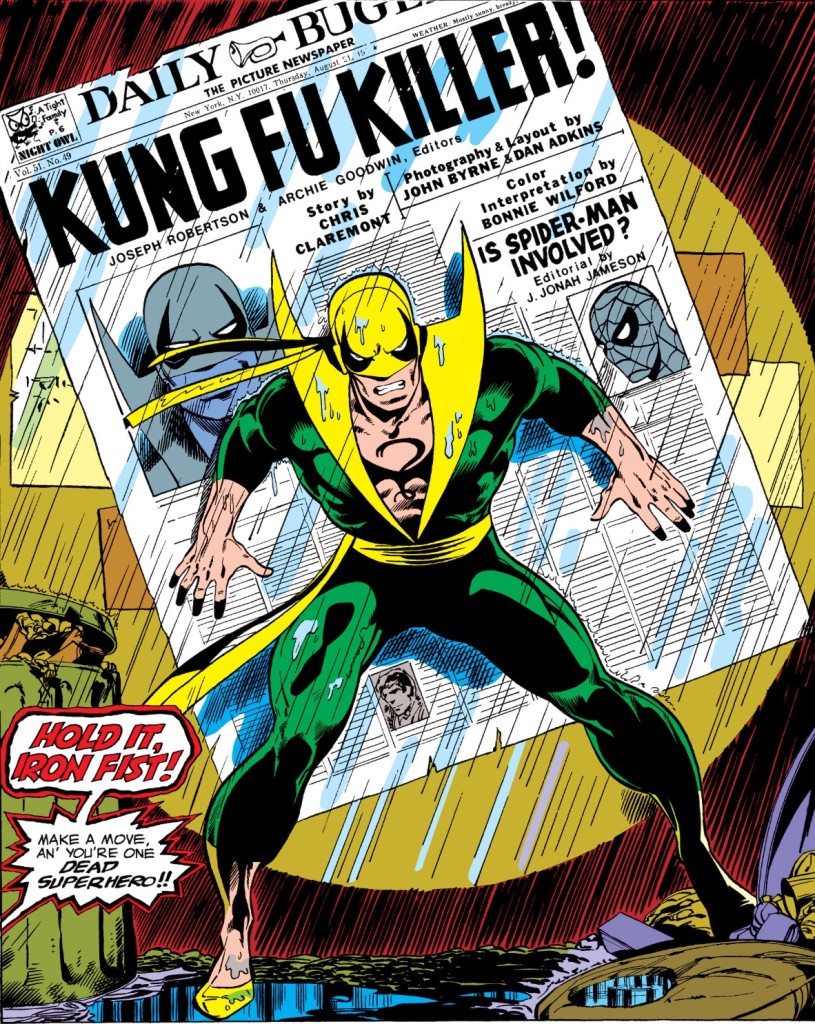
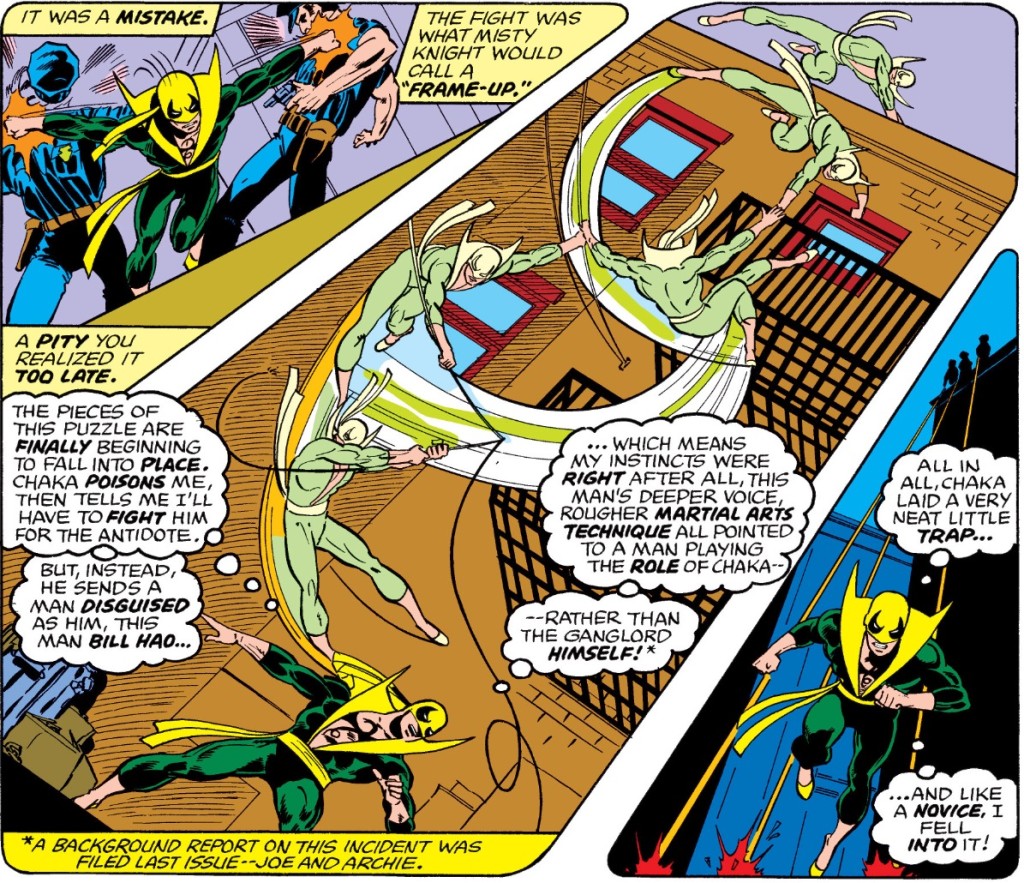
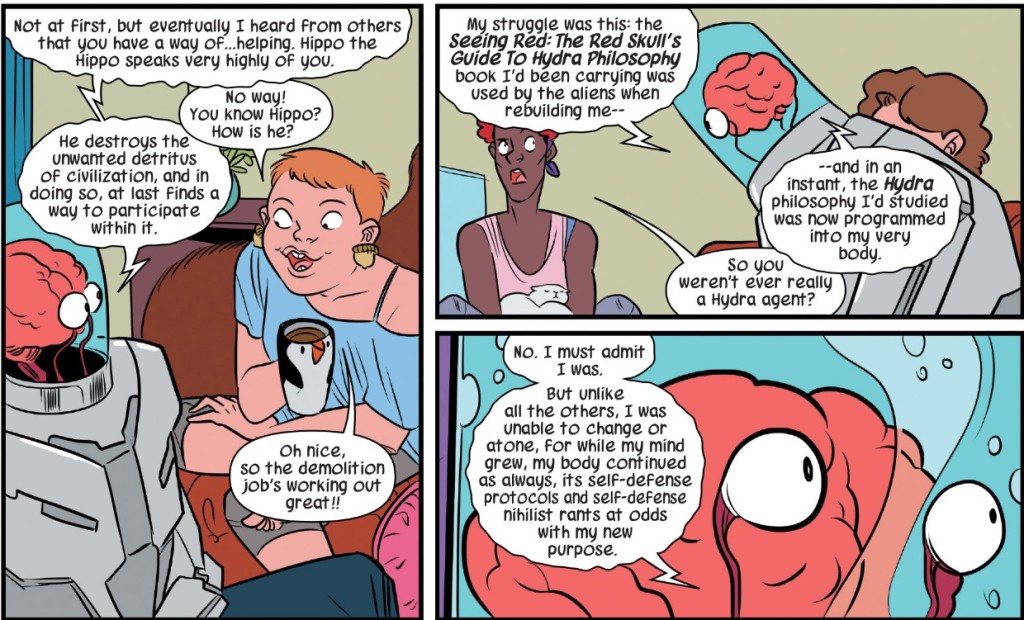
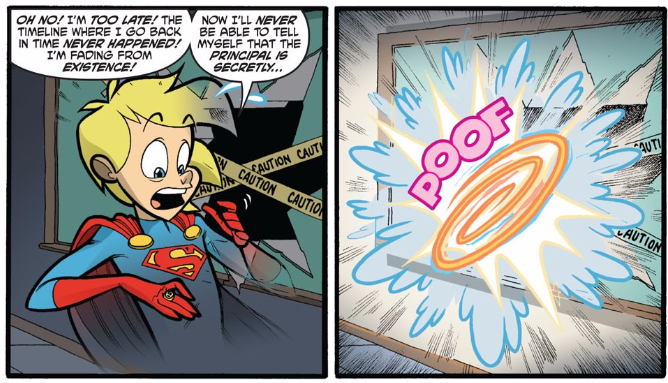
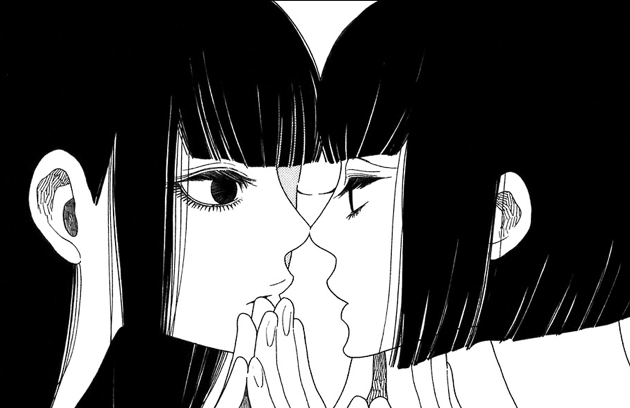
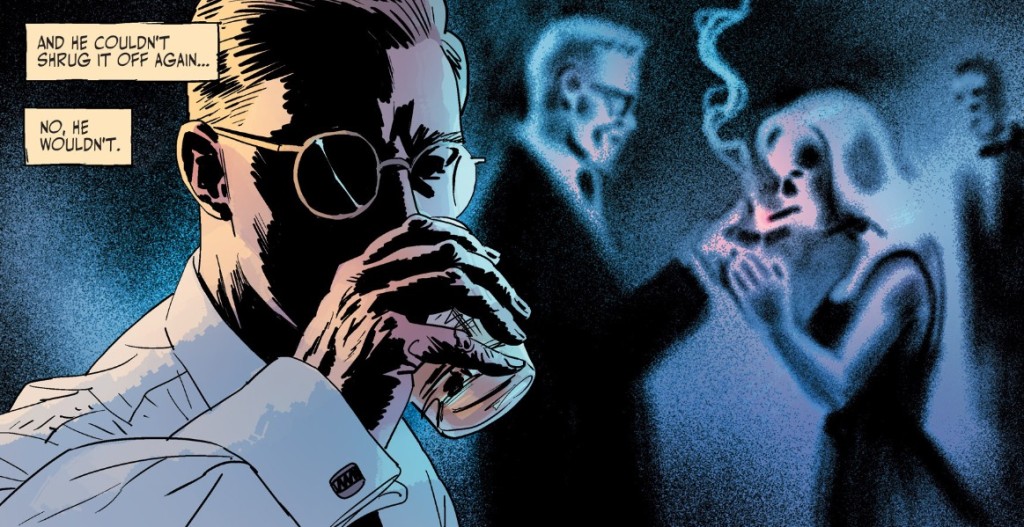
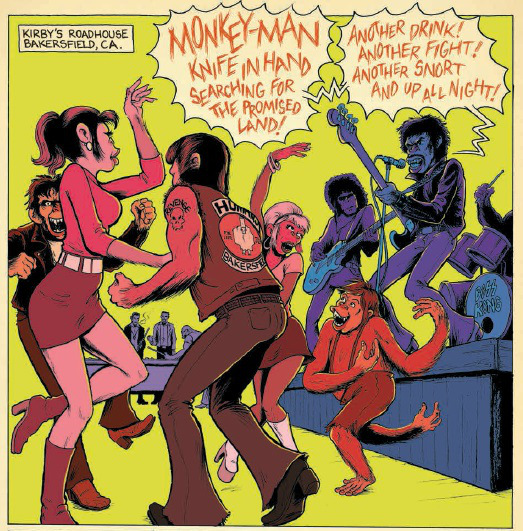
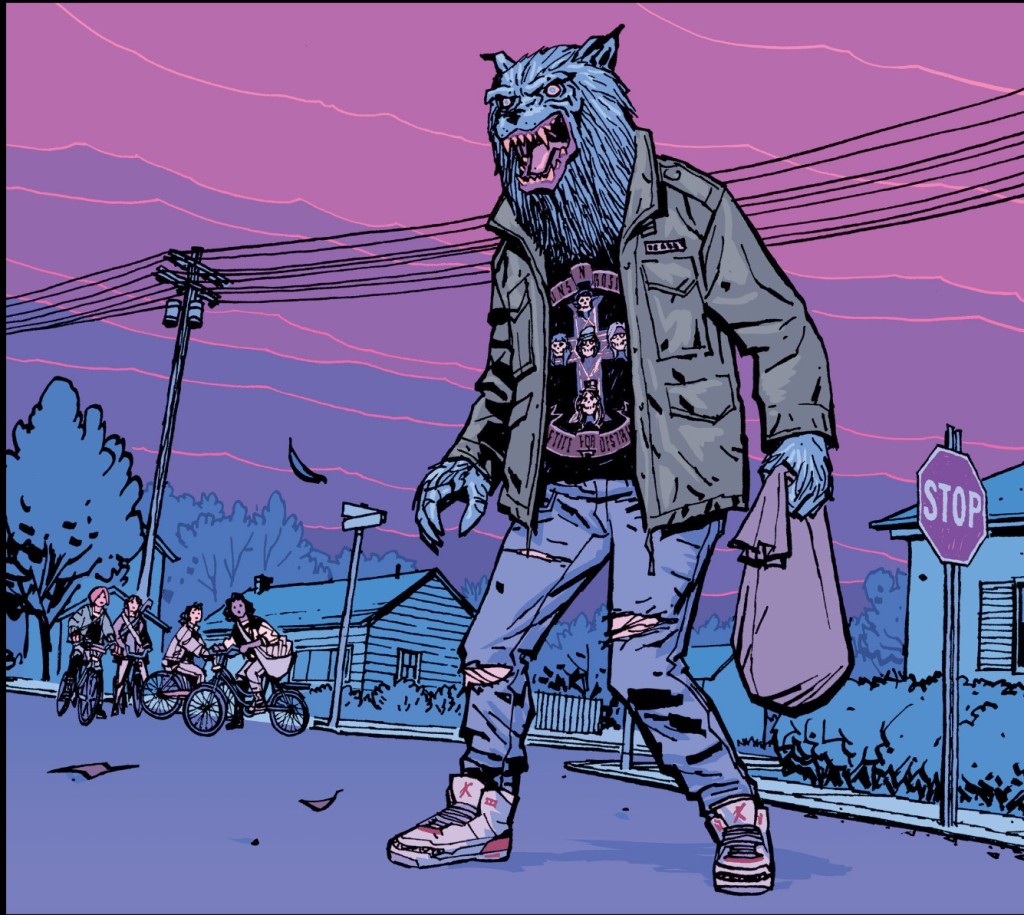
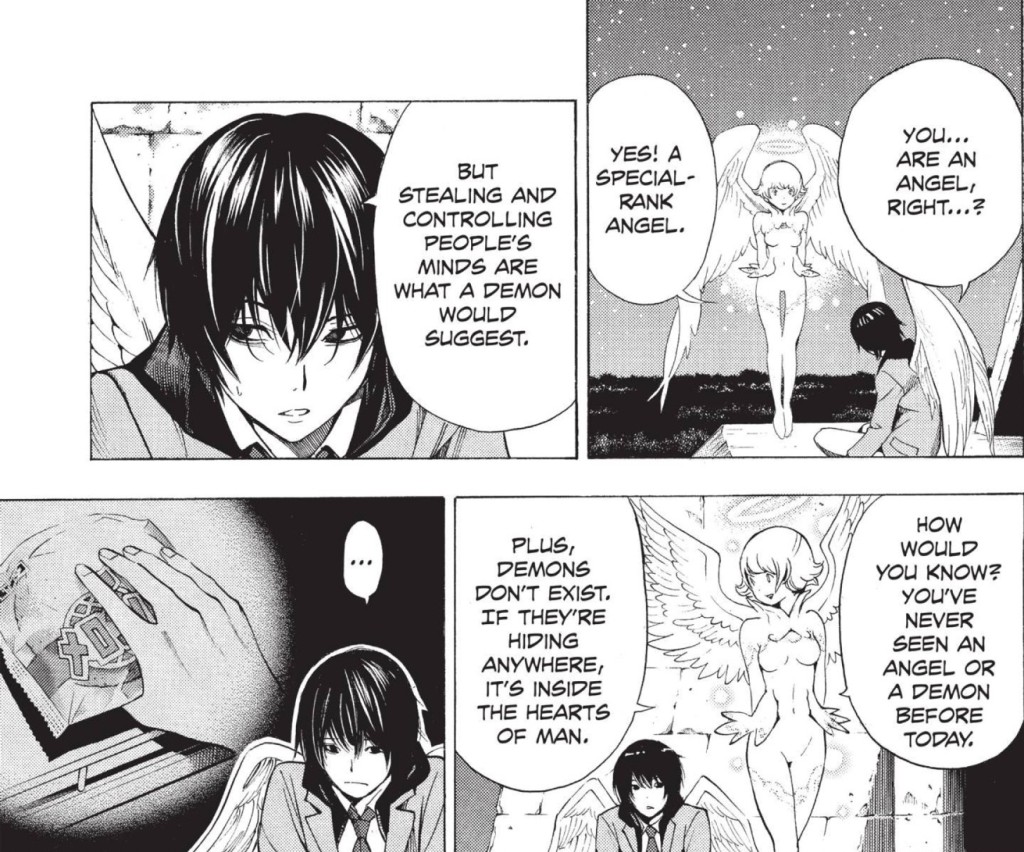
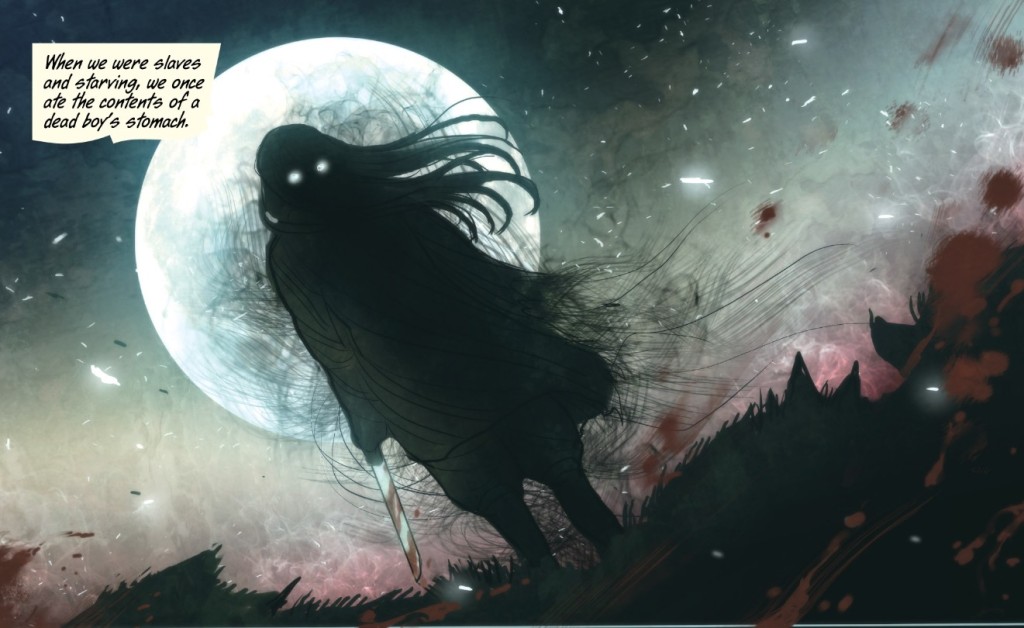
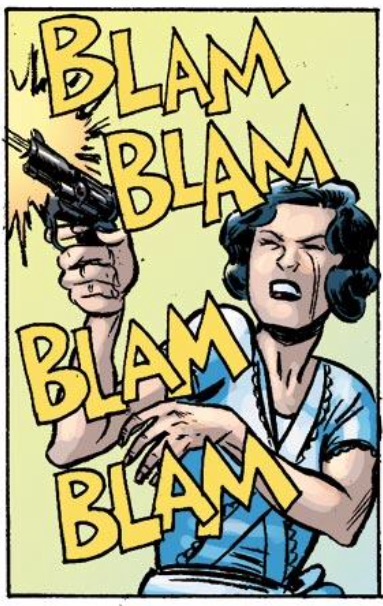
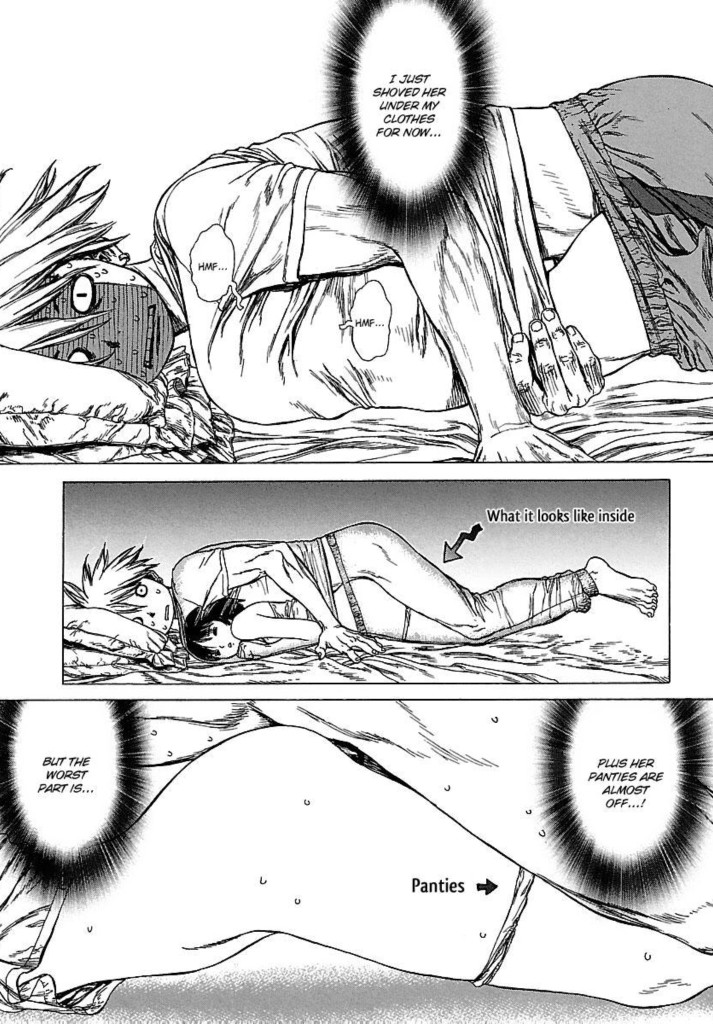
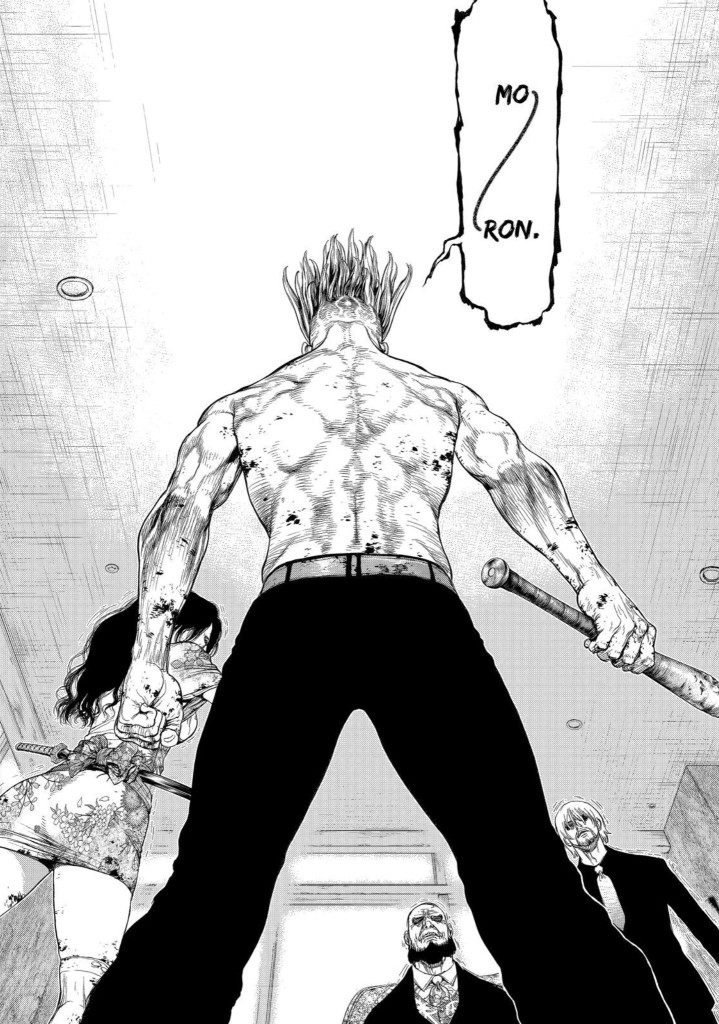
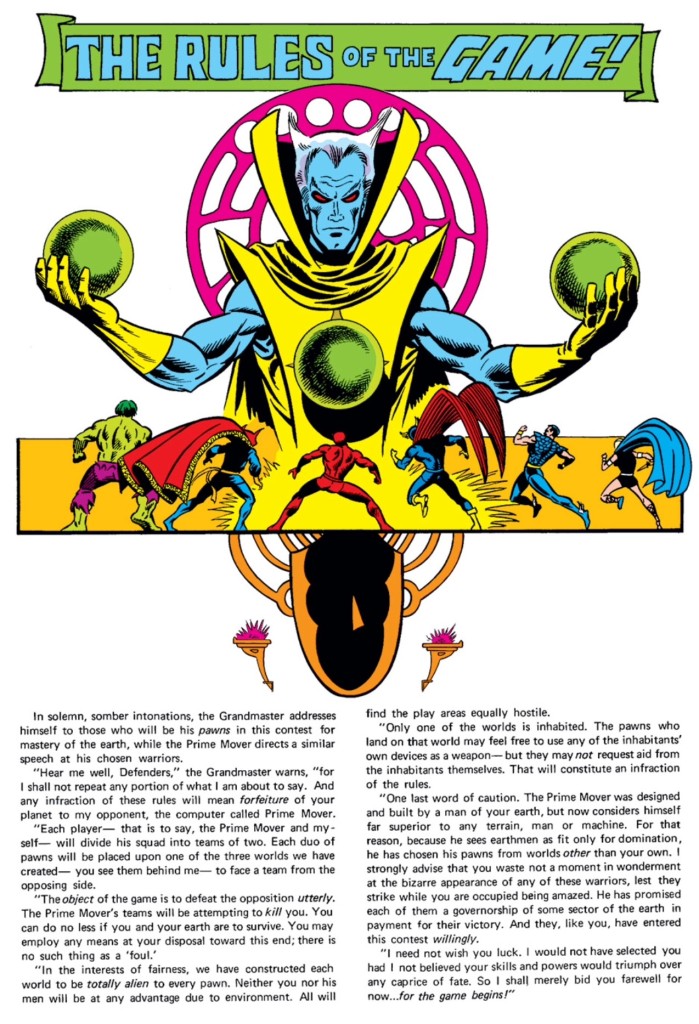
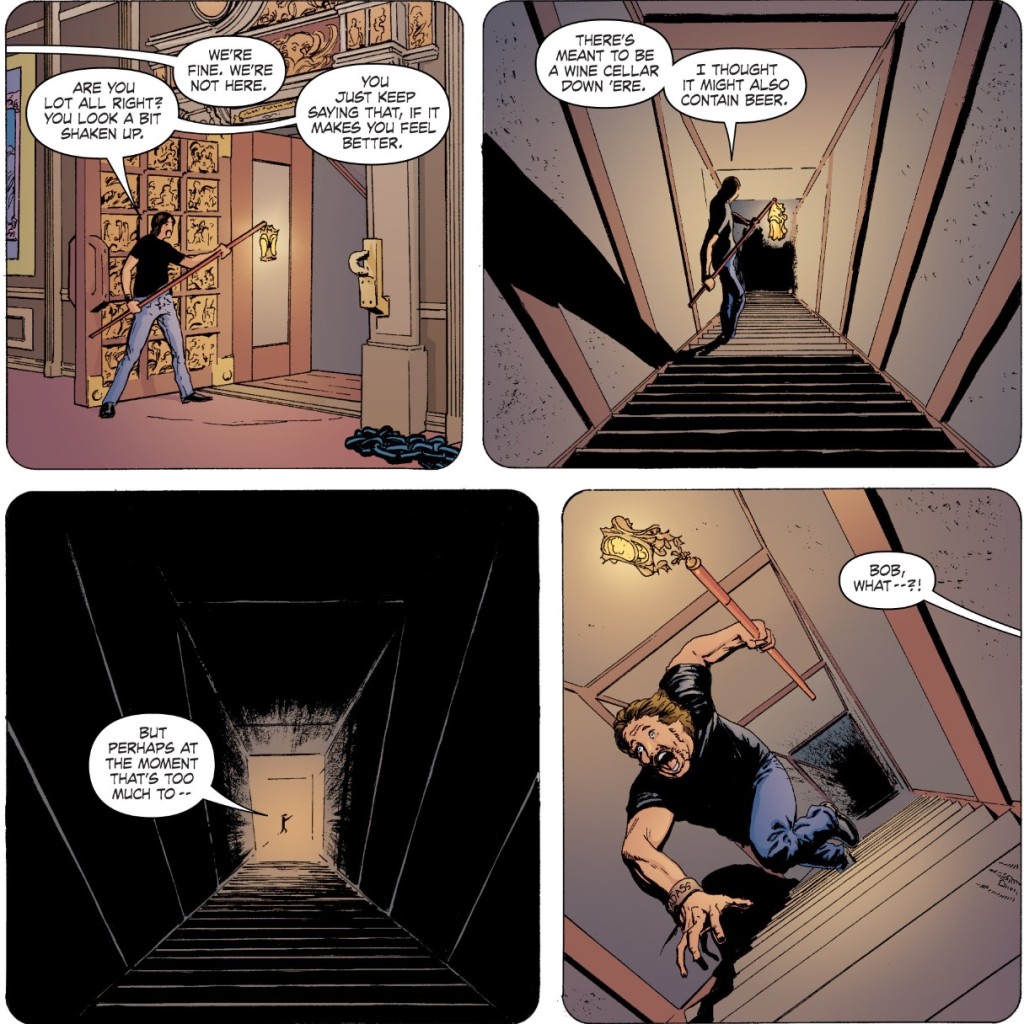


Oh man, what a great read.
A couple comments:
-Did you ever try Byrne’s revisit of Iron Fist when he brought him back in Namor? Maybe it’s because I was starting to read comics at the time, but somehow, the red-and-yellow suit was what became the iconic Iron Fist outfit for me. 8-year-old me thought that comic was the best while it was coming out, to the point that I’m a little afraid to revisit it.
-Re: Seven Soldiers: I feel like pretty much every series features Morrison building a mythology that gets ditched in about 5 seconds flat at some point, bar maybe Klarion and Manhattan Guardian. There are wildly interesting milieus that get abandoned all over the place (probably my favorite of which were Zatanna’s support group and Mr. Miracle’s homeless New Gods) that he abandons in the hopes of building the uber-plot. (Also, I kinda feel like, had Seven Soldiers come out about 5 years later, post-Game of Thrones, the Arthurian portion would have been the entire series.)
I have sooo much fondness for those Iron Fist issues. They’re among the first I bought for myself, and really shaped my imagination in a bunch of ways. I feel like they include some of Byrne’s very best dynamic layouts; I’ve wondered if he and Gulacy ever bothered paying attention to each other, or if it was independent invention drawing on shared inspirations.
Great stuff, Jeff.
Back when Seven Soldiers first came out, there was a lot of discussion about Zatanna as a not-so-thinly-veiled-shot at Alan Moore, but I don’t quite buy it. Moore’s all over Seven Soldiers but the commentary is more ambivalent than pointed, and Zatanna in particular ends on a kind of grace note; I read the series as more about Morrison attempting to resolve his anxiety of influence vis a vis Moore than about Moore himself.
This may also be why I’m not too worried about Zatanna’s ambivalence towards her situation, since it’s mirrored by some very ambivalent male leads (Jake Jordan, Shilo Norman) not to mention a creator who’s deeply ambivalent towards his own work and the traditions he’s writing in.
My long-weekend reads were mostly catching up on some Mignolaverse marginalia that I had let pile up.
Baltimore: I think I’m done with this one. There’s no sense that a conclusion is coming up (the initial villain is destroyed, but there was a even eviller one behind him!), and I get too much of “the world is doomed; the heroes can only slow the decay” from BPRD. And it’s not in the “main” Mignolaverse, so is easy to discard.
Witchfinder and Lobster Johnson: In terms of longterm plot, also seem stuck in a holding pattern. But they are much better set up to have amusing adventures in the meantime. Picking up more probably depends on the art teams assigned.
Sledgehammer 44. I wouldn’t mind seeing the character dragged into the BPRD present, but I hope the WWII setting is finished. There’s only so much you can squeeze between D-Day and VE day.
Frankenstein Underground. This was the winner of the group. Frankie gets cast in the old Hellboy role: punch things until he wins, or he falls through the floor. And it ends with a hint that there might be a loophole to the “it’s all doomed” problem eating away at my enjoyment of the Mignolaverse.
(This week is a skip week for the podcast? I can never keep track…)
Yup. We’ll be back with the next Wait, What? on December 7! And thanks for the sum-up of the Mignolaverse stuff: I keep trying to get into that material and, the occasional one-shot aside, just ricochet off pretty much every time.
Re: Morrison introducing ideas in Seven Soliders and then just dropping them.
Isn’t that kind of the point though? Each series was a small piece of something that could have filled many many more issues. In a way it feels like a proto version of Final Crisis, which had only a few pages given to individual ideas.
To me both projects deliberately feel like chucking lots of ideas out in an effort to say something about not getting bogged down in old ideas.
That being said, I think I would have preferred to just get 30 issues of Morrison and Irving on Klarion, but I still see the rapid raising and dropping of ideas to be a deliberate choice rather than an oversite.
Oh, yeah, it’s definitely a deliberate choice, which is why I said I don’t think he gets as much out of it as he thinks he is. (Although you are far from alone in disagreeing with me on that point.) Don’t get me wrong: on re-reads, I tend to dig it but I do think it helps add to the popular impression of Morrison as unfocused.
And by the time you get to the finale, it’s very obvious that at the very least, this rapid accrual and discarding of mythologies is very deliberate and thematically linked to the Seven Soldiers project.
I’m a bit surprised that Simone Bianchi’s art isn’t your thing. I was flipping through Shining Knight cause I was getting rid of those physical issues due to the Comixology Morrison sale. Looking at those Bianchi pages really made me think Sun-Ken Rock’s Boichii’s art is a bit similar. I mostly see similarities when it’s the big splash pages. Boichii does add the cartoonish panels, and has more energy in the lines. However I didn’t actually re-read the issue, so Bianchi’s storytelling could be terrible.
Just read the first two chapter of Sun-Ken Rock, and I’d read that even if the story was terrible just on the art alone. That is gorgeous stuff. As a big Crying Freeman fan, I’m looking forward to getting to the crazier stuff.
Can’t wait to dive into The Fade Out, I read the first four issues, and stopped, but I picked up the rest of the series so I can read in a sitting.
I first realized Morrison wasn’t that great at female characters during Invisibles, in which Boy turned out to be a total cipher (and, insultingly, the token black character created by a guy who isn’t great at writing black characters) and Ragged Robin turned out to be a proxy girlfriend for Morrison (in his King Mob fictionsuit)… Robin’s transformation didn’t really come to pass until Bloody Hell In America, but when it did it struck me as gross. Edith, at least, was a lovely well-rounded character, but Jolly Roger, criminy!
Realizing that the buzzword problematic may have been coined for Mozzer’s tendency to write really superficial women, I re-read Doom Patrol and squinted really hard at it. Somehow Crazy Jane isn’t insulting or bad, but between CJ & Dorothy it does feel that he can only write female characters– as opposed to caricatures, which he has no problem sketching –who are “nuts” (i.e. psychosexually scarred) or skeeved out by their own bodies. This isn’t out of place in Doom Patrol, but outside DP it becomes hard to ignore.
I’m not here to bash the man. He’s one of my favorite writers, but he doesn’t seem the ideal scribe for Wonder Woman. When you read his Earth-2 take on Diana, let us know how it turned out…
Just got around to reading this. You should totally do this every month – until your brain falls out.
Re Supergirl v Baltazar and Franco. Still haven’t read Supergirl, which I picked up for my daughter at Matt’s recc, but I did want to note that B&F’s work is definitely pitched to a younger crowd than the Telgemeier books (which my daughter is obsessed with). She loved Tiny Titans and Superman Adventures, read them over and over, but then got a little older and moved on to Smile etc. So I don’t think it’s a quality thing, it’s an age thing. That said, I think Tiny Titans works much better than Superman Family – more of a gag comic that suits their strengths.
Paper Girls is fine, but I’m having some issues with the slow pace – I may drop the singles in favor of trade just because I think it would be a better experience. I’m increasingly thinking Vaughn is not a great issue-t0-issue guy, but rather a better long-form guy. Chiang’s work is gorgeous as always, but I think he got a lot more to work with visually (if not script-wise) on the late Wonder Woman series.